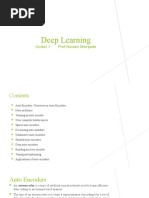0 ratings0% found this document useful (0 votes)
6 viewsAuto Encoder
Uploaded by
tanvi29khannaCopyright
© © All Rights Reserved
Available Formats
Download as PDF, TXT or read online on Scribd
0 ratings0% found this document useful (0 votes)
6 viewsAuto Encoder
Uploaded by
tanvi29khannaCopyright
© © All Rights Reserved
Available Formats
Download as PDF, TXT or read online on Scribd
You are on page 1/ 12
Autoencoders: Unsupervised Representation Learning
Department of Management
September 19, 2024
(Department of Management) Autoencoders: Unsupervised Representation Learning September 19, 2024 1 / 12
What are Autoencoders?
Autoencoders are neural networks used for unsupervised learning,
specifically designed to compress input data into a latent space and
then reconstruct it.
Consist of two parts: Encoder and Decoder.
End goal: Minimize the difference between the input and the output.
(Department of Management) Autoencoders: Unsupervised Representation Learning September 19, 2024 2 / 12
Motivation for Autoencoders
Dimensionality Reduction: Compress large datasets into
manageable latent spaces.
Data Compression: Similar to JPEG for images, but learns
non-linear relationships.
Noise Removal: Useful in denoising tasks.
Anomaly Detection: Identify anomalies by evaluating reconstruction
error.
(Department of Management) Autoencoders: Unsupervised Representation Learning September 19, 2024 3 / 12
Architecture of Autoencoders
Encoder: Transforms input into a compressed latent space.
Latent Space: The bottleneck layer where compressed information is
stored.
Decoder: Reconstructs the input from the latent space.
(Department of Management) Autoencoders: Unsupervised Representation Learning September 19, 2024 4 / 12
Mathematical Formulation
The goal is to minimize the reconstruction loss:
n
1X
L(x, x̂) = (xi − x̂i )2
n
i=1
x is the input and x̂ is the reconstructed input.
The network learns to compress and reconstruct by minimizing this
error.
(Department of Management) Autoencoders: Unsupervised Representation Learning September 19, 2024 5 / 12
Types of Autoencoders
Vanilla Autoencoder: Basic encoder-decoder structure.
Sparse Autoencoder: Enforces sparsity in the hidden layers to
reduce overfitting.
Denoising Autoencoder: Learns to reconstruct clean data from
noisy input.
Variational Autoencoder (VAE): Uses probabilistic distributions for
generating new data.
(Department of Management) Autoencoders: Unsupervised Representation Learning September 19, 2024 6 / 12
Sparse Autoencoders
Sparse Autoencoders enforce sparsity by applying L1 regularization to
the latent space.
They are useful for feature extraction in high-dimensional data.
(Department of Management) Autoencoders: Unsupervised Representation Learning September 19, 2024 7 / 12
Denoising Autoencoders
The goal is to train an autoencoder to remove noise from the input.
Process:
Input is a noisy version of the data.
The autoencoder learns to reconstruct the clean version.
(Department of Management) Autoencoders: Unsupervised Representation Learning September 19, 2024 8 / 12
Variational Autoencoders (VAEs)
VAEs differ from standard autoencoders by learning to generate data
from a latent space sampled from a distribution.
The encoder outputs a distribution (mean, variance) instead of a fixed
vector.
The loss function combines reconstruction loss and KL divergence:
LVAE = Reconstruction Loss + KL Divergence Loss
(Department of Management) Autoencoders: Unsupervised Representation Learning September 19, 2024 9 / 12
Applications of Autoencoders
Dimensionality Reduction: Like PCA but non-linear.
Image Generation: Using Variational Autoencoders.
Anomaly Detection: High reconstruction error indicates anomalies.
Pre-training Deep Networks: Useful for initializing weights.
(Department of Management) Autoencoders: Unsupervised Representation Learning September 19, 2024 10 / 12
Limitations of Autoencoders
Autoencoders can overfit if the latent space is too large.
May struggle with highly complex data distributions.
Linear dimensionality reduction (e.g., PCA) might be more efficient
for certain tasks.
(Department of Management) Autoencoders: Unsupervised Representation Learning September 19, 2024 11 / 12
Conclusion
Autoencoders are versatile tools for unsupervised learning, with
applications in dimensionality reduction, data denoising, and anomaly
detection.
Different variants, like sparse, denoising, and variational
autoencoders, provide tailored solutions for various tasks.
(Department of Management) Autoencoders: Unsupervised Representation Learning September 19, 2024 12 / 12
You might also like
- Sutton, 1983, Determination of Displacements Using An Improved Digital Correlation Method100% (2)Sutton, 1983, Determination of Displacements Using An Improved Digital Correlation Method7 pages
- 35-Gated RNNs - Optimization For Long-Term Dependencies - Explicit Memory-07!10!2024No ratings yet35-Gated RNNs - Optimization For Long-Term Dependencies - Explicit Memory-07!10!20243 pages
- 6. Brief Introduction on Current Research Areas - AutoencodersNo ratings yet6. Brief Introduction on Current Research Areas - Autoencoders20 pages
- Introduction To Data Learning AutoencodersNo ratings yetIntroduction To Data Learning Autoencoders8 pages
- Neural Network Unsupervised Machine Learning: What Are Autoencoders?No ratings yetNeural Network Unsupervised Machine Learning: What Are Autoencoders?22 pages
- Neural Network Unsupervised Machine Learning: What Are Autoencoders?No ratings yetNeural Network Unsupervised Machine Learning: What Are Autoencoders?22 pages
- MODULE 5 Auto-Encoders and Generative ModelsNo ratings yetMODULE 5 Auto-Encoders and Generative Models25 pages
- 7& 9 Autoencoder and Variational AutoencoderNo ratings yet7& 9 Autoencoder and Variational Autoencoder13 pages
- Jntuk r20 Unit-V Deep Learning Techniques (WWW - Jntumaterials.co - In)No ratings yetJntuk r20 Unit-V Deep Learning Techniques (WWW - Jntumaterials.co - In)61 pages
- Study Materials - Denoising AutoencodersNo ratings yetStudy Materials - Denoising Autoencoders7 pages
- Autoencoders: Presented By: 2019220013 Balde Lansana (No ratings yetAutoencoders: Presented By: 2019220013 Balde Lansana (21 pages
- Introduction To Autoencoders: A Brief OverviewNo ratings yetIntroduction To Autoencoders: A Brief Overview27 pages
- Sparse, Stacked and Variational Autoencoder | by Venkata Krishna Jonnalagadda | MediumNo ratings yetSparse, Stacked and Variational Autoencoder | by Venkata Krishna Jonnalagadda | Medium17 pages
- Autoencoders, Unsupervised Learning, and Deep ArchitecturesNo ratings yetAutoencoders, Unsupervised Learning, and Deep Architectures14 pages
- C 03 Variational Autoencoders Generative Adversarial NetworkNo ratings yetC 03 Variational Autoencoders Generative Adversarial Network54 pages
- Hidden Line Removal: Unveiling the Invisible: Secrets of Computer VisionFrom EverandHidden Line Removal: Unveiling the Invisible: Secrets of Computer VisionNo ratings yet
- Mobile Charging Station Placements in Internet of Electric Vehicles A Federated Learning ApproachNo ratings yetMobile Charging Station Placements in Internet of Electric Vehicles A Federated Learning Approach17 pages
- Escalado / PLC - 1 (CPU 1214C AC/DC/Rly) / Program BlocksNo ratings yetEscalado / PLC - 1 (CPU 1214C AC/DC/Rly) / Program Blocks2 pages
- The University of Dodoma: Project: World Wide TelescopeNo ratings yetThe University of Dodoma: Project: World Wide Telescope6 pages
- Sip Connect Technical Recommendation v11No ratings yetSip Connect Technical Recommendation v1145 pages
- Sig Sigma Implementation (DMAIC) of Friction Welding of Tube To TubeNo ratings yetSig Sigma Implementation (DMAIC) of Friction Welding of Tube To Tube7 pages
- Cryptocurrencies and Blockchain Technologies: Dan Boneh Benedikt Bünz Stanford UniversityNo ratings yetCryptocurrencies and Blockchain Technologies: Dan Boneh Benedikt Bünz Stanford University41 pages
- 1.2 Linear Equations and Rational Equations: SectionNo ratings yet1.2 Linear Equations and Rational Equations: Section15 pages
- Juniper Networks - (SRX) Example - Creating A PCAP Packet Capture On High-End SRX DevicesNo ratings yetJuniper Networks - (SRX) Example - Creating A PCAP Packet Capture On High-End SRX Devices2 pages
- Django: Python Web Framework Rayland Jeans CSCI 5448No ratings yetDjango: Python Web Framework Rayland Jeans CSCI 544840 pages
- ICT 34 Data Structures and Analysis of Algorithm100% (1)ICT 34 Data Structures and Analysis of Algorithm9 pages
- DIG The UK BIZ Links W Robert Hunter BidenNo ratings yetDIG The UK BIZ Links W Robert Hunter Biden27 pages
- Sutton, 1983, Determination of Displacements Using An Improved Digital Correlation MethodSutton, 1983, Determination of Displacements Using An Improved Digital Correlation Method
- 35-Gated RNNs - Optimization For Long-Term Dependencies - Explicit Memory-07!10!202435-Gated RNNs - Optimization For Long-Term Dependencies - Explicit Memory-07!10!2024
- 6. Brief Introduction on Current Research Areas - Autoencoders6. Brief Introduction on Current Research Areas - Autoencoders
- Neural Network Unsupervised Machine Learning: What Are Autoencoders?Neural Network Unsupervised Machine Learning: What Are Autoencoders?
- Neural Network Unsupervised Machine Learning: What Are Autoencoders?Neural Network Unsupervised Machine Learning: What Are Autoencoders?
- Jntuk r20 Unit-V Deep Learning Techniques (WWW - Jntumaterials.co - In)Jntuk r20 Unit-V Deep Learning Techniques (WWW - Jntumaterials.co - In)
- Autoencoders: Presented By: 2019220013 Balde Lansana (Autoencoders: Presented By: 2019220013 Balde Lansana (
- Sparse, Stacked and Variational Autoencoder | by Venkata Krishna Jonnalagadda | MediumSparse, Stacked and Variational Autoencoder | by Venkata Krishna Jonnalagadda | Medium
- Autoencoders, Unsupervised Learning, and Deep ArchitecturesAutoencoders, Unsupervised Learning, and Deep Architectures
- C 03 Variational Autoencoders Generative Adversarial NetworkC 03 Variational Autoencoders Generative Adversarial Network
- Hidden Line Removal: Unveiling the Invisible: Secrets of Computer VisionFrom EverandHidden Line Removal: Unveiling the Invisible: Secrets of Computer Vision
- Mobile Charging Station Placements in Internet of Electric Vehicles A Federated Learning ApproachMobile Charging Station Placements in Internet of Electric Vehicles A Federated Learning Approach
- Escalado / PLC - 1 (CPU 1214C AC/DC/Rly) / Program BlocksEscalado / PLC - 1 (CPU 1214C AC/DC/Rly) / Program Blocks
- The University of Dodoma: Project: World Wide TelescopeThe University of Dodoma: Project: World Wide Telescope
- Sig Sigma Implementation (DMAIC) of Friction Welding of Tube To TubeSig Sigma Implementation (DMAIC) of Friction Welding of Tube To Tube
- Cryptocurrencies and Blockchain Technologies: Dan Boneh Benedikt Bünz Stanford UniversityCryptocurrencies and Blockchain Technologies: Dan Boneh Benedikt Bünz Stanford University
- 1.2 Linear Equations and Rational Equations: Section1.2 Linear Equations and Rational Equations: Section
- Juniper Networks - (SRX) Example - Creating A PCAP Packet Capture On High-End SRX DevicesJuniper Networks - (SRX) Example - Creating A PCAP Packet Capture On High-End SRX Devices
- Django: Python Web Framework Rayland Jeans CSCI 5448Django: Python Web Framework Rayland Jeans CSCI 5448

























































































